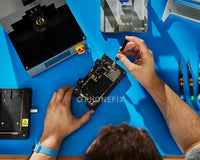Have you experienced a non-responsive throttle? What was the cause, and how did you fix it? A non-responsive throttle isn’t just frustrating; it’s a serious safety risk. Today, let’s dive into the root causes, actionable fixes to keep this issue at bay.
When you press the pedal, the throttle pedal position sensor TPS sends an electrical signal to the ECU, which then tells the electronic throttle body ETB how far to open. Any breakdown in this chain causes unresponsiveness. 
Top 6 Causes of Throttle Pedal Failure.
1. Carbon Buildup on the Electronic Throttle Body (ETB).
Over time, oil vapors, dust, and fuel residue can coat the ETB’s butterfly valve, causing its response to gradually decrease, resulting in unstable idling, sluggish acceleration, and the engine malfunction indicator lamp illuminating, among other issues.
DIY Fix:
Disconnect the battery (wait 10 minutes to reset the ECU).
Remove the air intake hose connected to the ETB.
Spray throttle body cleaner onto the valve (avoid getting it on electrical connectors).
Use a soft brush to gently remove carbon deposits.
Reassemble and reconnect the battery. Test drive to confirm improvement.
2. Faulty Throttle Position Sensor (TPS).
The TPS is a tiny potentiometer that wears out over time. A failing TPS sends incorrect signals to the ECU, leading to miscommunication.
DIY Fix:
Use V519 OBD-II scanner to confirm the error code.
Locate the TPS, disconnect the electrical connector and remove the sensor. Install the new TPS and reconnect the connector. And clear the error code with the scanner and test drive.
3. Damaged Wiring or Corroded Connectors.
Electrical signals can’t travel through frayed wires or rusted connectors. This can result in intermittent unresponsiveness, flickering dashboard lights, no check engine light.
DIY Fix:
Inspect the wiring harness between the pedal, ETB, and ECU.
Clean corroded connectors with electrical contact cleaner.
Repair frayed wires with heat-shrink tubing or replace the harness if damage is severe.
Re-seat all connectors firmly to ensure a tight fit.
4. Fuel System Failures.
Even a perfect throttle system can’t work if the engine isn’t getting enough fuel. such as slow acceleration, sputtering engine, inability to reach high speeds, empty fuel gauge.
5. Software Glitches or Outdated ECU Firmware.
The ECU relies on software to interpret sensor data. Outdated firmware or temporary glitches can cause miscommunication.
Please visit a dealership to update the ECU firmware, or update it yourself using an OBD-II scanner, such as the Xhorse Multi-prog programmer, but please operate with caution.
6. Mechanical Obstructions.
Sometimes the problem is literal, something is blocking the pedal or ETB, such as misaligned floor mat, debris in the ETB intake or bent throttle linkage.
If you’re on the road when the throttle stops responding, you should stay calm, panic leads to poor decisions. Use your brakes to slow down gradually. Turn on your hazard lights to alert other drivers. Pull over to a safe spot and turn off the engine. And call for roadside assistance or a mechanic, do NOT attempt to drive further. 
Preventive Maintenance to Avoid Throttle Issues. Replace the fuel filter and air filter at recommended intervals. Use high-quality fuel and check wiring and connectors annually, etc.
Modern throttle systems rely on precise voltage feedback, digital signals, and micro-control logic that can fail silently when a sensor, connector, or circuit malfunctions. These subtle issues can disable an entire machine even when no visible fault is present. Remember to regular maintenance is the best way to avoid this issue.
Why Is My Vehicle Throttle Pedal Unresponsive?










